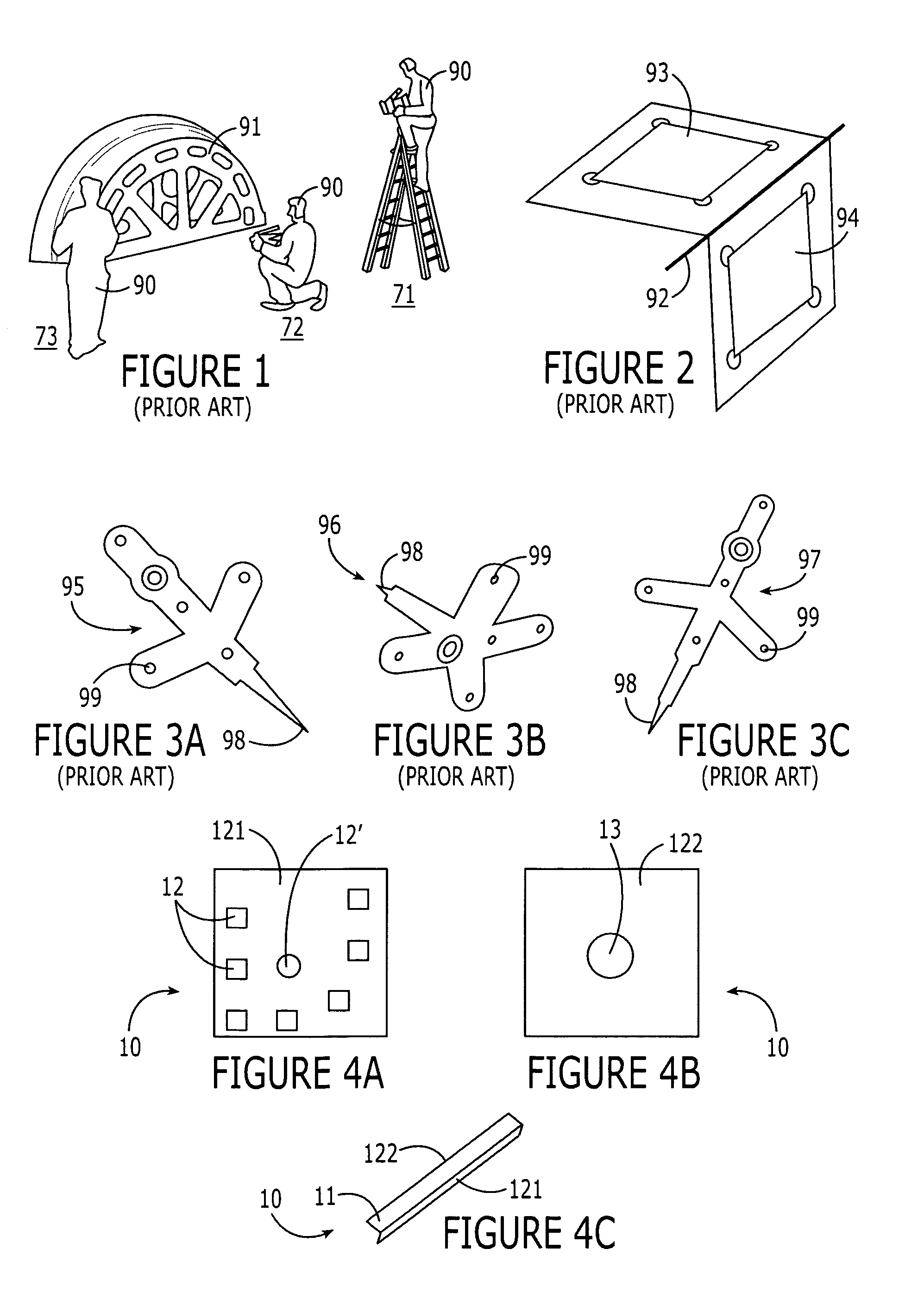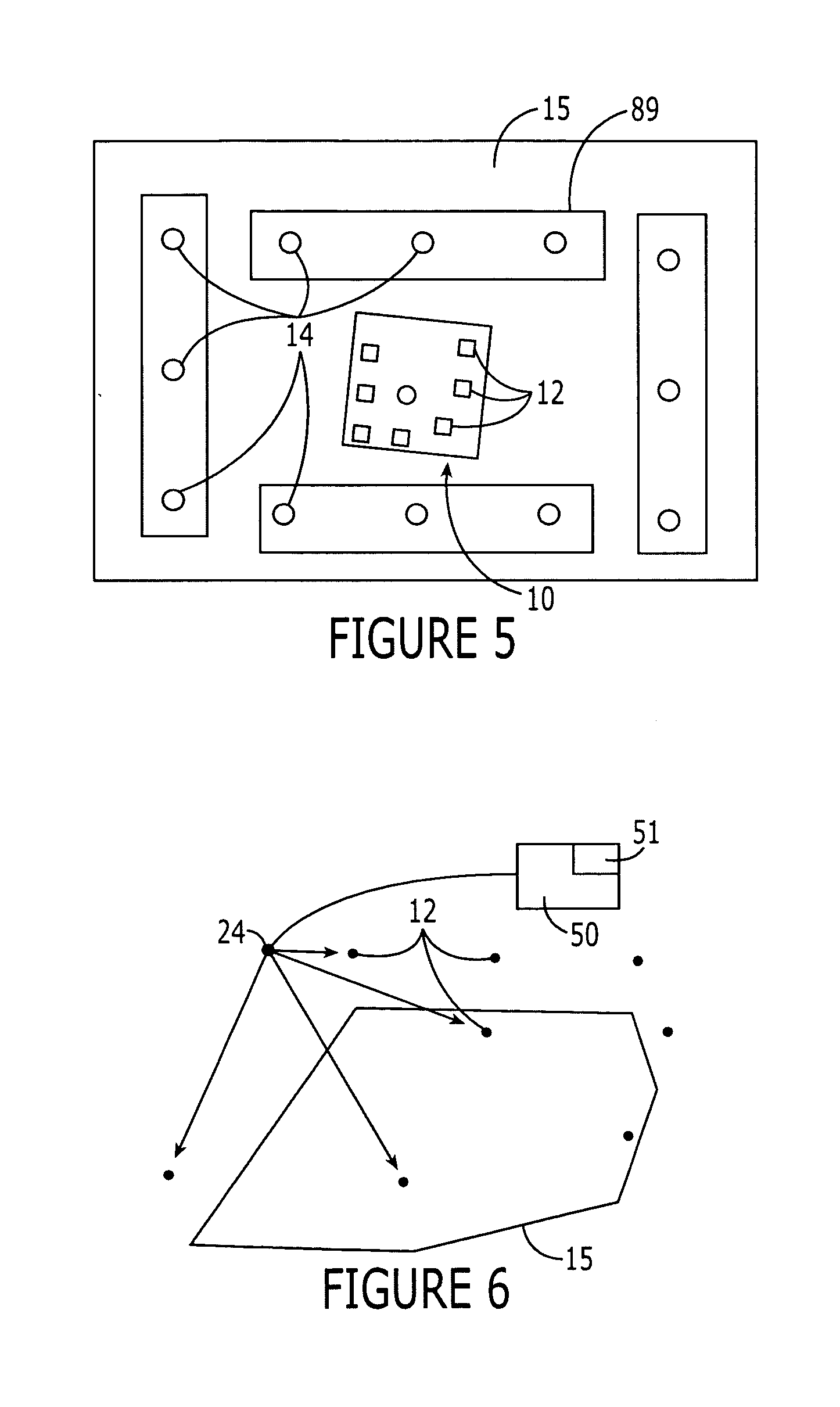Photogrammetric measurement system and method
- Summary
- Abstract
- Description
- Claims
- Application Information
AI Technical Summary
Benefits of technology
Problems solved by technology
Method used
Image
Examples
first embodiment
[0044]the FT 10 is for measuring a plane. This FT (FIGS. 4A–4C) comprises a planar base 11, comprising, for example, a flat piece of aluminum. The top side 121 of the base 11 has a plurality of coded targets 12,12′ thereon (FIG. 4A); the bottom side 122 of the base 11 has at least one magnet 13 embedded therein to hold the FT 10 in place. This positioning device is exemplary and is not intended to be limiting, and it will be understood by one of skill in the art that alternate affixing methods are able to be substituted therefor, such as an adhesive for affixing to nonmetallic portions of objects. The relationship between the targets 12,12′ on the top side 121 of the base 11 and the plane represented by the base 11 is determined by a one-time calibration.
[0045]The FT 10 is placed on a flat surface 89 such as granite (FIG. 5). Retroreflective targets 14 are placed adjacent the FT 10 and are used to define a “local” plane 15. A photogrammetric measurement is then made to determine the...
case 1 (fig.9a)
[0060]In Case 1 (FIG. 9A), analysis of production tooling requires a fast and efficient measurement system. The driving factors are time and availability for analysis. Case 2 (FIG. 9B) illustrates the need for immediate information for decision making during production. In both cases the need for uninterrupted production schedules is deemed extremely important.
[0061]In the case of production tooling measurement, unavailability of tooling during after-shift hours due to routine maintenance needs, and constantly changing production schedules due to high product demand, has forced inspection personnel into working during scheduled break times. This means finding a way to measure a tool during a normal 40-min lunch break with the goal of eventually completing the measurement during a 10-min coffee break.
[0062]The ability to flexibly analyze product deviation in-line is the focus of the second case study. Increasingly, inspection is needed at the point of origin in order to efficiently d...
case 1
[0063] In this study a 1.8-m-long panel-holding fixture (FIG. 9A) is desired to be measured, to determine the location of features such as corners, edges, and planes on the fixture.
[0064]An FT 10 was placed on each of the desired features. Where possible, one was used. For features without a suitable target, the necessary data were created using a combination of FTs.
[0065]An exemplary sample clamping mechanism is illustrated in FIG. 10, wherein four FTs 20–23 are shown. The FT 20 at the back of the clamp 88 is used to define a contact plane. The three remaining FTs 21–23 define the hard corner of the clamping surface. The fixture measurement required a total of 40 FTs to measure all the desired features.
[0066]After targeting a total of 60 photographs were taken of the fixture 88. The number of photographs taken depends on the complexity of the measurement and accuracy requirements. The photography for the fixture 89 was completed in approximately 5 min. Camera station locations 24 f...
PUM
 Login to View More
Login to View More Abstract
Description
Claims
Application Information
 Login to View More
Login to View More - R&D
- Intellectual Property
- Life Sciences
- Materials
- Tech Scout
- Unparalleled Data Quality
- Higher Quality Content
- 60% Fewer Hallucinations
Browse by: Latest US Patents, China's latest patents, Technical Efficacy Thesaurus, Application Domain, Technology Topic, Popular Technical Reports.
© 2025 PatSnap. All rights reserved.Legal|Privacy policy|Modern Slavery Act Transparency Statement|Sitemap|About US| Contact US: help@patsnap.com



